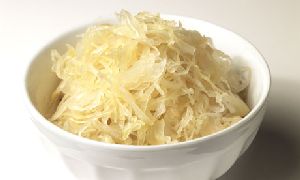
Some of you may think sauerkraut, isn’t there a better tasting food to
write about ? Sauerkraut is cabbage that has been fermented in salt.
The word sauerkraut means “sour cabbage” in German. The Chinese
are credited for the creation of sauerkraut more than 2,300 years ago.
Originally it consisted of shredded cabbage that was pickled in wine.
Workers building the Great Wall of China were among the first to
enjoy it. Around the end of the 16th century, salt was used in place of
wine in the fermentation process. It produced a better product, and it’s
a recipe that’s still used today. How is sauerkraut made today ?
Cabbage is planted in March and harvested in August. After being
harvested the heads of cabbage are washed and shredded. The
shredded cabbage is mixed with salt and tightly packed into huge
stainless steel or fiberglass-lined vats to ferment during fermentation,
lactic acid is created. This is what gives Sauerkraut its unique flavor
and texture. After about 6 weeks, fermentation is complete and the
sauerkraut is ready for packing In the average year over 185, 000
tons of cabbage are grown for making Sauerkraut Most of it is grown
in Central N.Y. and Wisconsin. Phelps, N.Y. is the Sauerkraut capital
of the world, and has hosted an annual “Sauerkraut Festival” each
August for the last 40 years. It takes one-tenth of a head of cabbage to
make one 14.4 ounce can. Great Lakes Kraut Company produces
about 90 percent of the sauerkraut manufactured in the U.S. One last
thought, If Great Lakes Kraut Company were to make all the
Sauerkraut in 14.4 ounce cans, it would stretch halfway around the
world. That is a lot of Sauerkraut !! Sauerkraut is only second to
mustard as America’s favorite hot dog topping.
To reduce the amount of sodium in sauerkraut, just rinse or soak it in
cold water. Source: www.sauerkrautnews .com
FOR THE HEALTH OF IT
Sauerkraut isn’t really good for you , is it ?
YES ! Eating sauerkraut has many health benefits.
One cup of sauerkraut has:
Just 32 calories
No fat or cholesterol
4 grams of fiber
35% DV vitamin C
102% DV vitamin K
12% DV Iron
Plus vitamin B6, folate, calcium, potassium, and copper.
Sauerkraut is a cruciferous vegetable. According to the U.S.
Department of Health and Human Services, eating several
servings of cruciferous vegetables a week (Sauerkraut, cabbage,
brussels sprouts, cauliflower, broccoli, and turnips) can reduce
the risk of colon cancer.
Source: www.sauerkrautnews .com

Leave A Comment